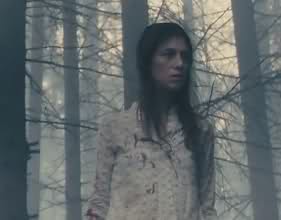Before being kicked out of 2011’s Cannes Film Festival, writer/director Lars Von Trier was no stranger to controversy. He has received as much acclaim for his art house films as he has criticism. Perhaps his most violent work to date is 2009’s Antichrist. By Von Trier’s own admission, Antichrist was supposed to be a horror film. It is graphic and has full nudity in some scenes, but there aren’t any scares. For the most part, the movie is a study of two characters: a husband (played by Willem Dafoe) and his wife (played by Charlotte Gainsbourg). Neither of their names are given to us.
The Husband is a therapist who doesn’t believe in psycho-pharmacology as a tool to heal the mind. When the couple’s young son dies tragically, The Wife has a mental breakdown. The doctors describe her grief pattern as “atypical.” Tired of seeing his wife confined to a hospital bed, The Husband takes it upon himself to cure her. He believes that “grief is not a disease” and it should be treated through talking and confronting one’s fears.
Both travel to Eden, the name they’ve given to a secluded cabin in the forest. Since this is a highbrow horror flick, the movie is shot beautifully and meticulously. Expect to see extraordinary detail like dust particles in the air. There’s also lots of slow motion in various scenes for dramatic effect. There’s pornographic activity and nudity, too. The Wife is naked from the waist down for most of the final sequences.
Each of the film’s dark visuals is supposed to mean something very deep, I’m sure. But try to figure out what everything is supposed to mean. For example, the couple has sex at the bottom of a tree. The tree’s branches and roots then turn into arms and limbs. In another instance, The Husband finds a fox devouring itself. The fox turns to him and says, “chaos reigns.” The Husband also encounters ghostly visions at the end of the film. Interestingly, The Wife has no such hallucinations.
While it’s The Wife who goes insane in this film, it’s Willem Dafoe’s performance as The Husband that steals the show. His expressive face and alluring voice are perfect for the part. He’s conflicted between being a husband, a therapist and a man. Although The Wife is the movie’s villain, she is not nearly as interesting as The Husband. There is much more to him, things that go unsaid.
As mentioned previously, The Husband is the one who has weird visions (and he heard an animal say something). He also finds evidence that his wife lost her mind before their son’s death – but he never acts on many of those findings. When the film presents us with slow-motion scenes, they’re usually centered on The Husband. For example, glorious acorns fall from oak trees around The Husband in one slow-motion sequence. Yet, given all of these factors, Antichrist never presents The Husband as having issues of his own.
Beneath the extremely fancy decorations, sex and haunting imagery of Antichrist, there lie basic but intriguing themes. Can a man separate himself from being a loving husband and become an unbiased therapist? Was The Wife an incompetent mother? How does a mother deal with the fear of not being a good mother?
In her state of increasing mental torment, The Wife begins to believe that she’s evil. She’s evil not because she thinks she’s an incompetent mother; she’s evil because she’s a woman. According to the wife’s psychosis, all women are evil because they are witches. Witches in the traditional, medieval sense; the ones who were burned at the stake.
Because she believes she is inherently evil, The Wife goes after The Husband and her own femininity. Two scenes in particular will make you squirm. The first is when The Wife clobbers The Husband in the nuts (ouch). The Second is when she commits sexual self-mutilation. Needless to say, these are very difficult and painful scenes to watch.
“Antichrist” is a vast, intimidating title for a movie that only big shoes can fill. Director/writer Lars Von Trier believed his shoes were big enough for the task. To add to the extravagance of an already self-important and wishfully profound film, it is divided into chapters like a book. But in looking past director Von Trier’s pretension you will find a decent story that is worth two hours of your time.
Thank you for reading
michael




Great well thought out review. I was a big fan of Lars Von Trier’s THE KINGDOM, parts 1 and 2 make a great 7 hour horror marathon. Too bad all the principles started dying before he could make part 3.